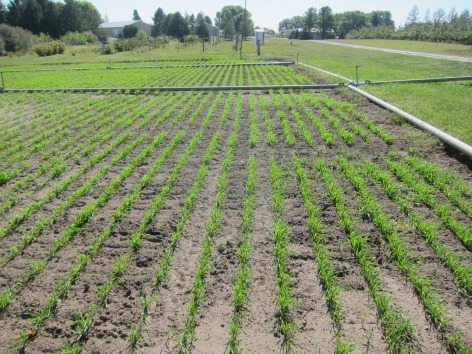
Cereal rye is a good option for Iowa growers looking into cover crops because of its ability to withstand cold temperatures. Larger image. Photo courtesy of Ajay Nair.
AMES, Iowa – As vegetable growers and commodity farmers reach the end of the growing season and harvest their crops, faculty at Iowa State University are pushing for greater awareness of cover crops to conserve soil and hold nutrients in place through the fall and winter.
Iowa State professors from a range of disciplines are reaching out to producers and landowners in an effort to expand the use of cover crops in the state, a goal that has the potential to protect the environment while improving yields.
A range of benefits
Growing cover crops, or plants that cover farmland during the months when land traditionally would not be in production, can unlock huge benefits for growers if done correctly, said Ajay Nair, an assistant professor of horticulture. The most obvious is that cover crops hold soil in place during the fall and winter months. Farmland that’s left bare during the off months runs the risk of losing topsoil to erosion set in motion by precipitation.
“One of the most important things to understand is at the end of the growing season, we don’t want the land to be left uncovered,” Nair said. “If that happens, rain and snow in the fall and winter will take away topsoil. The cover crops reduce erosion, suppress weed germination, add organic matter and stimulate soil microbial activity.”
A second advantage is that cover crops recycle critical nutrients, especially nitrogen, in the soil, Nair said. The cover crop will store the nitrogen and stop it from leaching away. When the cover crops are tilled back into the soil, the stored nitrogen becomes available to the cash crops that will be planted on the land, he said.
What makes a good cover crop?
Nair has hosted a series of workshops this fall on the use of cover crops in commercial fruit and vegetable production. The workshops cover the topic from many angles, including what types of plants make for ideal cover crops in Iowa, ideal cover crop seeding rates and methods.
Nair said Iowa growers have options, but cereal rye is a common species because of its ability to withstand winter conditions. Rye is able to germinate in temperatures as low as 38 degrees Fahrenheit.
A legume known as hairy vetch is another option because of its ability to retain nitrogen in the soil. A grower can add between 60 and 80 pounds of nitrogen per acre by planting hairy vetch as a cover crop, Nair said.
Effort to educate landowners
Farmers are more likely to plant cover crops if they see a benefit in making such an investment. However, researchers in the ISU Greenlee School of Journalism found much of the literature on cover crops is targeted to men, when women own or co-own around 50 percent of the farmland in Iowa.
“We found a huge portion of the audience isn’t being reached. Women landowners want to know these things; it’s just no one is looking at them,” said Michael Dahlstrom, an assistant professor in journalism. “We wanted to bring them into the conversation because once they have the information they can make decisions that will have a huge impact on the state.”
Dahlstrom and Joel Geske, an associate professor of journalism, worked with Women, Food and Agriculture Network to develop new cover crop brochures targeted at women. The information was distributed through a series of meetings to nearly 120 women landowners, who own a combined 24,300 acres of farmland in Iowa.
Researchers said more than 50 percent of the women adopted at least one of the recommended steps. This included taking a pledge to talk to their tenants, if they rented the land, or working with their tenants to share the cost of planting a cover crop on a small test plot between 20 and 40 acres.
Geske said many women were initially reluctant to talk with their tenants about the issue because they didn’t have all the facts or they were afraid they would lose a tenant. Giving women the information they needed made it easier to have that conversation.
“We have an aging population in Iowa and this is going to continue to be a trend in which women outlive men and a large amount of the land will be owned by women,” Geske said. “One of Iowa’s greatest assets is its soil. So to be able to do something to educate landowners and help protect the soil is good for the state.”
Geske and Dahlstrom are now working with Women, Food and Agriculture Network to expand the program to seven Midwestern states. The group received a $500,000 USDA grant to focus on overall soil health. The next phase has the potential to reach women with a combined 311,000 acres of farmland.